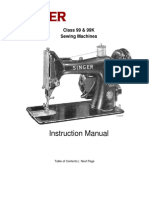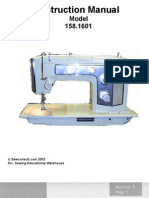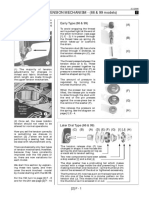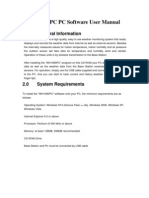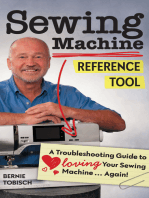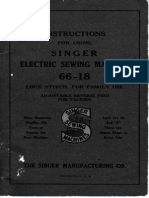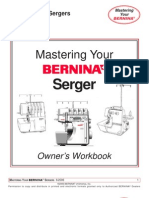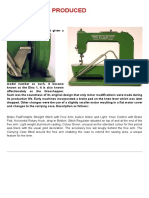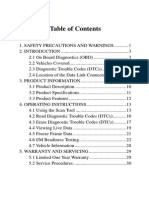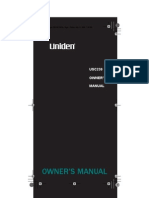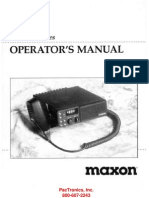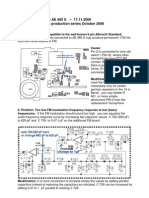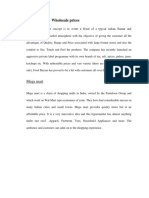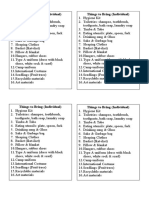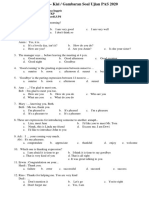No. 15 Instruction Manual
No. 15 Instruction Manual
Uploaded by
AndyCopyright:
Available Formats
No. 15 Instruction Manual
No. 15 Instruction Manual
Uploaded by
AndyOriginal Title
Copyright
Available Formats
Share this document
Did you find this document useful?
Is this content inappropriate?
Copyright:
Available Formats
No. 15 Instruction Manual
No. 15 Instruction Manual
Uploaded by
AndyCopyright:
Available Formats
Sewing Machine No.
15
(WITH ATTACHMENTS 120603)
OSCILLATING SHUTTLE, FOR FAMILY USE
No. 15 Instruction Manual
Table of Contents | Next Page
Sewing Machine No. 15
Table of Contents
Instructions for Instructions for
Operating the Machine Using the Attachments
Main Parts Foot Hemmer -- Hemming
To Take out the Bobbin Foot Hemmer -- Hemming and
To Wind the Bobbin Sewing on Lace
To thread the Bobbin Case Foot Hemmer -- Felling
To Replace the Bobbin Case Adjustable Hemmer -- Hemming
To Set the Needle Adjustable Hemmer -- Wide Hemming
To Thread the Needle Beinder -- Binding
To Prepare for Sewing Tucker
To Commence Sewing Ruffler
To Remove the Work To Attach the Ruffler to the Machine
Tensions To Adjust the Ruffler for Gathering
To Regulate the Tensions To Make a Ruffle and Sew it to
To Regulate the Length of Stitch a Garment in One Operation
To Turn a Corner To Ruffle and Sew on a
To Regulate the Pressure on the Material Facing in One Operation
Piping a Ruffle
HINTS To Adjust the Ruffler for Plaiting
The Belt To Adjust the Ruffler for
Machine Working Heavily Group Plaiting and Gathering
To Avoid Breaking Needles To Oil the Ruffler
Breaking of Needle Thread
Breaking of Bobbin Thread
Skipping of Stitches
To Oil the Machine
Previous Page | Next Page
Sewing Machine No. 15
Main Parts
Table of Contents Previous Page | Next Page
3
Sewing Machine No. 15
INSTRUCTIONS FOR OPERATING THE MACHINE
Raise the presser foot (2, Fig 3) by means of the presser bar lifter
(3, Fig. 3) to prevent injury to the foot (2, Fig. 3) and feed (1, Fig. 3).
FIG. 3. FRONT VIEW OF THE MACHINE
It is necessary to understand the stop motion (5, Fig, 3) by which the balance wheel (4, Fig.
3) can be released when required, thus enabling the operator to become proficient in the use
of the treadle, and permitting the winding of bobbins without running the stitching mechanism.
It also allows the operator to wind bobbins without removing partially sewn work and without
unthreading the machine.
Previous Page | Next Page
4
Sewing Machine No. 15
To release the balance wheel (4, Fig. 3, page 3) turn the stop motion screw (5, Fig. 3, page 3)
over toward you. It will be necessary to hold the balance wheel while loosening the stop
motion screw.
After releasing the balance wheel, place your feet upon the treadle and with the right hand
turn the balance wheel over toward you. This will start the band wheel, treadle and pitman,
the sewing mechanism having been disconnected.
Continue the motion thus begun by an alternate pressure of heel and toe, until a regular and
easy movement is acquired, and the balance wheel kept continuous rotation by use of the
feet alone.
When you are thoroughly familiar with the treadle movement, and can restart the machine
without turning the balance wheel in the wrong direction tighten the stop motion screw to
connect the balance wheel with the stitching: mechanism.
Place a piece of cloth under the presser foot, let the foot down upon it, and operate the
machine in this way without being threaded, until you have become accustomed to guiding
the material.
To Ensure Perfect Action of the Machine
The balance wheel must always turn over toward the operator.
Do not run the machine with the presser foot resting on the feed without cloth under the
presser foot.
Do not run the machine when both bobbin case and needle are threaded unless there is
material under the presser foot.
Do not try to help the machine by pulling the fabric lest you bend the needle. The machine
feeds the work without assistance.
The slide over the bobbin case should be kept closed when the machine is in operation.
Table of Contents Previous Page | Next Page
5
Sewing Machine No. 15
To Take Out the Bobbin
Draw to the left the slide in the bed of the machine Reach down with the thumb and forefinger
of the left hand, open the bobbin case latch (2, Fig. 4) and lift out the bobbin case. While the
latch remains open, the bobbin is retained in the bobbin case. Release the latch, turn the
open end of the bobbin case downward and the bobbin will drop out.
FIG. 4. TAKING OUT THE BOBBIN CASE
Table of Contents Previous Page | Next Page
6
Sewing Machine No. 15
To Wind the Bobbin
Release the balance wheel (4, Fig. 3) by turning the stop motion screw (5, Fig. 3) over toward you.
FIG. 5. MACHINE THREADED FOR WINDING THE BOBBIN
Place the bobbin on the bobbin winder spindle (8, Fig. 6) and push it up closely against the
shoulder, having the small pin in the spindle enter the slot in the side of the bobbin. Put the
spool of thread on the spool pin (1, Fig. 5). Pass the end of the thread into the thread guide
(2, Fig. 5) at the left and near the top of the arm, then up into the lower eyelet (3, Fig. 6) of
the bobbin winder thread guide, into the notch (4, Fig. 6) and pass the thread through the slot
in the left side of the bobbin from the inside. Press the bobbin winder pulley (5, Fig. 6) down
on the balance wheel hub, and the latch (7, Fig. 6) will drop down and hold it. Then operate
the treadle the same as for sewing.
Table of Contents Previous Page | Next Page
7
Sewing Machine No. 15
The end of the thread must be held by the hand until a few coils are wound and should then
be broken off. When sufficient thread has been wound upon the bobbin, the bobbin winder is
automatically released from the balance wheel.
If the pressure of the rubber ring (5, Fig. 6) against the hub of the balance wheel is
insufficient for winding the bobbin, loosen the adjusting screw (6, Fig. 6) and press the bobbin
winder lightly until the rubber ring is in contact with the hub of the balance wheel; then tighten
the screw.
FIG. 6. WINDING THE BOBBIN
Table of Contents Previous Page | Next Page
8
Sewing Machine No. 15
To Thread the Bobbin Case
Hold the bobbin between the thumb and
forefinger of the right hand, the thread
leading on top from the left toward the right
(see Fig. 7).
FIG. 7
With the left hand hold the bobbin case as
shown in Fig. 7, the slot in the edge being at
the top, and place the bobbin into it.
FIG. 8
Then pull the thread into the slot in the edge
of the bobbin case (see Fig. 8), draw the
thread down under the tension spring and
into the delivery at the end of the tension
spring (see Fig. 9).
FIG. 9
Table of Contents Previous Page | Next Page
9
Sewing Machine No. 15
To Replace the Bobbin Case
After threading, take the bobbin case by the latch, holding it between the thumb and
forefinger of the left hand. Place the bobbin case on the centre stud (1, Fig. 4) of the shuttle
body with the position finger (1, Fig. 10) opposite the notch at the top of the shuttle race,
release the latch and press the bobbin case back until the latch catches the groove near the
end of the stud. Allow the thread to hang free and close the slide in the bed of the machine.
FIG. 10. BOBBIN CASE THREADED AND REPLACED
Table of Contents Previous Page | Next Page
10
Sewing Machine No. 15
To Set the Needle
Turn the balance wheel over toward you until the needle bar (9, Fig. 5) moves up to its
highest paint, loosen the thumb screw (10, Fig 5) in the needle clamp (11, Fig. 5) and put the
needle up into the clamp as far as it will go, with its flat side toward the right, then tighten the
thumb screw.
To Thread the Needle
(See FIG. 11)
Turn the balance wheel over tow toward you
until the thread take-up lever (5) is raised to
its highest point. Place the spool of thread on
the spool pin at the top of the machine, lead
the thread toward the left through the thread
guide (1) at the back and at the top of the
face plate, down, under and from back to
front between the tension discs (2) up back of
the tension thread guard (3), down into the
loop of the takeup spring (4), up and from
back to front through the hole in the end of
the thread take-up lever (5), down into the
eyelet (6) in front of the face plate, into the
lower wire guide (7), then from left to right
through the eye of the
needle (8).
Draw about two inches of thread through the
eye of the needle with which to corn com-
mence sewing.
FIG. 11 THREADING THE NEEDLE
Table of Contents Previous Page | Next Page
11
Sewing Machine No. 15
To Prepare for Sewing
With the left hand hold the end of the needle thread, leaving it slack from the hand to the needle.
FIG. 12 DRAWING UP THE BOBBIN THREAD
Turn the balance wheel over toward you until the needle moves down and up again to its highest point,
thus catching the bobbin thread; draw up the needle thread and the bobbin thread will come up with it
through the hole in the throat] plate (see Fig. 12). Lay both threads back under the presser foot.
To Commence Sewing
Place the material beneath the presser foot, lower the presser foot and commence to sew, turning the
balance wheel over toward you.
To Remove the Work
Let the thread take up lever rest at its highest point, raise the presser foot and draw the fabric back and to
the left, pass the threads over the thread cutter (1, Fig. 12) and pull down lightly to sever them. Leave the
ends of the threads under the presser foot.
Table of Contents Previous Page | Next Page
12
Sewing Machine No. 15
Tensions
For ordinary stitching, the needle and bobbin threads should be locked in the centre of the
thickness of the material, thus:
FIG. 13. PERFECT STITCH
If the tension on the needle thread is too tight, or if that on the bobbin thread is too loose, the
needle thread will lie straight along the upper surface of the material, thus:
FIG. 14. TIGHT NEEDLE THREAD TENSION
If the tension on the bobbin thread is too tight or if that on the needle thread is too loose, the
bobbin thread will lie straight along the under side of the material, thus:
FIG. 15. LOOSE NEEDLE THREAD TENSION
To Regulate the Tensions
The tension on the needle thread should only be regulated when the presser foot is down.
Having lowered the presser foot, turn the small thumb nut (12, Fig. 5) at the front of the
tension discs over toward you to increase the tension. To decrease the tension, turn the
thumb nut over from you.
Table of Contents Previous Page | Next Page
13
Sewing Machine No. 15
The tension on the bobbin thread is regulated by the screw (1, Fig. 8) in the bobbin case tension
spring. To increase the tension, turn the screw over to the right. To decrease the tension, turn the
screw over to the left.
When the tension on the bobbin thread has been once properly adjusted, it is seldom necessary to
change it, as a correct stitch can usually be obtained by varying the tension on the needle thread.
To Regulate the Length of Stitch
The length of stitch is regulated by the large thumb screw (14, Fig. 6) in the slot on the front of the
arm near the bobbin winder.
To lengthen the stitch, loosen this screw and move it downward. To shorten the stitch, move the
screw upward. When the desired length of stitch is obtained, tighten the thumb screw.
To Turn a Corner
Stop the machine with the needle at its lowest point. Raise the presser foot and turn the work as
desired, using the needle as a pivot.
To Regulate the Pressure on the Material
For ordinary family sewing, it is seldom necessary to change the pressure on the material. If sewing
fine silk or flimsy material, lighten the pressure by turning the thumb screw (13, Fig. 5) on the top of
the machine over to the left. To increase the pressure, turn this screw over to the right. The pres-
sure should be only heavy enough to prevent the material from rising with the needle and to enable
the feed to move the work along evenly; a heavier pressure will make the machine run hard.
To Sew Flannel or Bias Seams
Use a short stitch and as light a tension as possible on the needle thread so as to have the thread
loose enough in the seam to allow the goods to stretch if necessary.
A Stitch to Ravel Easily
can be made if desired, by having the tension on the needle thread so light that the bobbin thread
will not draw into the goods but lie straight, as shown in Fig. 15.
Table of Contents Previous Page | Next Page
14
Sewing Machine No. 15
HINTS
The Belt. See that the belt is not too tight; it should always be tight enough to not slip. If too
loose, remove the hook at one end, shorten the belt and rejoin.
Machine Working Heavily. If the machine runs hard after standing idle for some time, use a
little kerosene in the oiling places. run the machine rapidly, then wipe clean and oil.
To Avoid Breaking Needles. See that the presser foot or attachments are securely fastened
by the thumb screw. Do not sew heavy seams or very thick goods with too fine a needle. A
large needle and thread to correspond should be used on heavy work.
See that the needle is not bent and avoid pulling the material when stitching.
Breaking of Needle Thread. If the needle thread breaks it may be caused by:
• Improper threading.
• Tension being too tight.
• The thread being too coarse for size of needle.
• The needle being bent, having a blunt point, or being set incorrectly
Breaking of Bobbin Thread. If the bobbin thread breaks it may be caused by:
• Improper threading of bobbin case.
• Tension being too tight.
Skipping of Stitches. The needle may not be accurately set into the needle bar or the
needle may be blunt or bent. The needle may be too small for the thread in use.
Table of Contents Previous Page | Next Page
15
Sewing Machine No. 15
To Oil the Machine
To ensure easy running, the machine and stand require oiling and if used continuously should
be oiled each day. With moderate use, an occasional oiling is sufficient. Oil should be applied
at each of the places shown by arrows in Figs. 10, 16 and 17. One drop of oil at each point is
sufficient. Oil holes are provided in the machine for bearings which cannot be directly
reached.
FIG. 16. OILING POINTS AT THE FRONT OF THE MACHINE
Draw to the left the slide in the bed of the machine and apply a few drops of oil to the shuttle
race (2, Fig. 10). The slide should then be closed.
Loosen the screw (1, Fig. 16) near the upper end of the face plate, raise the plate and slip it
off over the head of the screw; put one drop of oil into each of the oil holes and joints.
Table of Contents Previous Page | Next Page
16
Sewing Machine No. 15
On the back of the arm is a round plate or cover, fastened by a thumb screw; loosen the
screw, turn the plate upward and fasten by tightening the screw; turn the balance wheel
slowly and oil the moving parts inside, then turn the cover down and fasten it as before.
To reach the parts underneath the bed, the belt must be thrown oil the band wheel on the
machine stand. For this purpose a belt shifter (6, Fig. 1) is placed at the front of the band
wheel. By pressing the belt shifter lever to the left and working the treadle meanwhile, the belt
is released and the head can then be turned back on its hinges. The places to be oiled are
indicated in Fig. 17, by arrows pointing to the oil holes and bearings.
FIG. 17. OILING POINTS IN BASE OF MACHINE
To oil the stand, put a drop of oil on the centres on which the band wheel and treadle work,
and both ends of the pitman rod which connects the treadle with the band wheel.
Table of Contents Previous Page | Next Page
17
Sewing Machine No. 15
INSTRUCTIONS FOR USING THE ATTACHMENTS
FOOT HEMMER - Hemming
Raise the needle to its highest point. Remove the presser foot and attach the foot hem mer in
its place (see Fig. 18). Clip off the right hand corner of the cloth, so that it will take the roll
easily, turn up the edge about a quarter of an inch, insert it in the mouth of the hemmer and
draw or push it along until under the needle. Then let down the presser bar and after taking
two or three stitches, draw gently on the ends of the threads to help the work along till the
feed catches it. In order to produce a smooth even hem, the mouth of the hemmer must be
kept just full.
FIG. 18
Fig. 18 shows also what is known as a bag seam or fell, made by passing two pieces of fab-
ric through the hemmer together and hemming them down.
Table of Contents Previous Page | Next Page
18
Sewing Machine No. 15
FOOT HEMMER - Hemming and Sewing on Lace
Start the hem as previously explained, and when it is well started, raise the needle to its
highest point. Raise the hemmer to relieve its pressure on the hem, pass the end of the lace
through the slot in the side of the hemmer, under the back of the hemmer and over the hem,
as shown in Fig. 19.
Take care that the hem is not displaced in the hemmer and that the needle goes down
through the lace and hem together. Then let down the presser bar and guide the lace over
the front of the hemmer, keeping it well into the slot.
FIG. 19
Table of Contents Previous Page | Next Page
19
Sewing Machine No. 15
FOOT HEMMER - Felling
The two pieces of cloth to be felled should be laid one over the other, rightsides together, the
edge of the under piece being a little farther to the right than the upper piece. Stitch them
together, using the hemmer as a presser foot, the front end of the hemmer forming a guide
for the edges of both pieces, the upper piece being guided by the inside and the under piece
by the outside of the projecting front of the foot hemmer (see Fig. 20).
FIG. 20
Table of Contents Previous Page | Next Page
20
Sewing Machine No. 15
Then open the work out flat, wrong side up, the edges standing up straight, and taking the
edges near the beginning of the seam in the right hand and the ends of the threads in the left
hand, draw the edges into the hemmer which will turn them as in hemming. Guide the second
row of stitching by following the first row with the inside of the projecting front of the foot
hemmer (see Fig. 21.)
FIG. 21
Table of Contents Previous Page | Next Page
21
Sewing Machine No. 15
ADJUSTABLE HEMMER - Hemming
Remove the presser foot and attach the adjustable hemmer in its place as shown in Fig. 22.
This hemmer will turn hems from 3/16 inch to 1 in. wide. The adjustment is made by
loosening the thumb screw on the hemmer and moving the slide to the right or left until the
hem turned is of the desired width. Enter the edge of the cloth into the hemmer under the
scale and draw it back and forth until the hem is formed, stopping with the end under the
needle. Lower the presser bar and commence to sew being careful to so guide cloth as to
keep hemmer full. Felling can also be done with the adjustable hemmer by following
instructions on pages 19 and 20.
FIG. 22
Table of Contents Previous Page | Next Page
22
Sewing Machine No. 15
ADJUSTABLE HEMMER - Wide Hemming
To make a hem more than one inch wide, take out the thumb screw in the hemmer and
remove the slide and pointer; fold and crease down a hem of the desired width; pass the fold
under the extension at the right of the hemmer, and the edge into the folder as shown in Fig.
23 and proceed to stitch the hem.
FIG. 23
Table of Contents Previous Page | Next Page
23
Sewing Machine No. 15
BINDER - Binding
Remove the presser foot and attach the binder in its place. Pass the binding through the
scroll of the binder and draw it back under the needle. Place the edge of the goods to be
bound between the scrolls of the binder and draw it under the needle. Lower the presser bar
and sew as usual. To make French folds, proceed as directed for binding except that the fold
is stitched on to the face of the material instead of on the edge (see Fig. 24). After loosening
the binder set screw and adjusting the binder, the line of stitching can be brought nearer the
centre, this being more effective when making French folds.
FIG. 24
Table of Contents Previous Page | Next Page
24
Sewing Machine No. 15
TUCKER
Remove the presser foot and attach the tucker in its place. The width of the tuck is
determined by the scale of figures nearest the needle, which shows in eighths and sixteenths
of an inch the distance of the edge of the fold from the line of stitching.
The crease or mark for the second and following tucks is determined by the scale nearest the
operator and this is set by the line in front of the needle hole in the presser foot. For blind
tucks without spaces, adjust the scale nearest the operator so that the figure opposite the line
on the presser foot will be the same as that at which the guide is located on the scale nearest
the needle. To make spaces between the tucks, move the front scale farther to the left until
the desired space is obtained.
FIG. 25
Table of Contents Previous Page | Next Page
25
Sewing Machine No. 15
Having adjusted the scales for tuck and space as desired, fold the material and crease by
hand; pass the folded edge between the spring and spur near you, then between the two
blades of the second scale, and back under the presser foot; draw to the right against the
guide, lower the presser bar; see that the lever for the needle clamp to strike is in its back-
ward position so as to form a crease for the next tuck, then proceed with the first tuck.
For the second tuck, fold carefully at the crease made by the spur and place the edge of the
first tuck underneath and against the spur at the left. The spur will serve as a guide and will
also make a distinct crease for the next tuck. Always place the last tuck against the spur to
ensure perfect work.
When making the last tuck, the lever upon which the needle clamp strikes while tucking
should be raised to its highest point; while the lever is in this position no crease for a
succeeding tuck is made upon the goods.
Table of Contents Previous Page | Next Page
26
Sewing Machine No. 15
Ruffler
Lines 1, 2, 3, 4 and 5 shown in Fig. 26 indicate where the material is to be placed for various
operations, as follows:
FIG. 26. THE RUFFLER AND ITS PARTS
Table of Contents Previous Page | Next Page
27
Sewing Machine No. 15
Line 1 - the correct position for the material F - ADJUSTING FINGER - the part which
to which the ruffled material is regulates the width or size of the plaits.
applied.
Line 2 - material to be willed. G - SEPARATOR GUIDE - the guide on the
Line 3 - the facing for the ruffle. underside of the ruffles, containing slots into
Line 4 - the strip of piping material. which the edge of the material is placed to
Line 5 - the edge to be piped. keep the heading of the ruffle even; also for
separating the material to be ruffled from the
Refer to Fig. 26 when inserting the material in material to which the ruffle is to be attached.
the ruffler.
H - RUFFLING BLADE - the upper blue steel
The names and uses of the principal parts of blade with the teeth at the end to push the
the ruffler are as follows: material in plaits up to the needle.
(SEE REFERENCES IN FIG. 26) J - SEPARATOR BLADE - the lower blue
steel blade without teeth, which prevents the
A - FOOT - the part by which the ruffler is
teeth of the ruffling blade coming into contact
attached to the presser bar.
with the feed of the machine, or the material
to which ruffle or plaiting is to be applied.
B - FORK ARM - the section that must be
placed astride the needle clamp.
C - ADJUSTING SCREW - the screw that
regulates the fullness Of the gather.
D - PROJECTION - the part that projects
through the slots in the adjusting lever.
E - ADJUSTING LEVER - the lever that sets
the ruffler for gathering or for making a plait
once at every six stitches or once at every
twelve stitches, as desired; also for disengag-
ing the ruffler, when either plaiting or gather-
ing is not desired.
Table of Contents Previous Page | Next Page
28
Sewing Machine No. 15
To Attach the Ruffler to the Machine
Raise the needle bar to its highest point and remove the presser foot. Attach the presser foot
(A, Fig. 26) to the presser bar by means of the thumb screw, at the same time placing the
fork arm
(B. Fig. 26) astride the needle clamp as shown in Fig. 27.
To Adjust the Ruffler for Gathering
The adjusting finger (F. Fig 27) is not intended for gathering and should be moved forward or
away from the needle, shown Fig. 27.
FIG. 27
Table of Contents Previous Page | Next Page
29
Sewing Machine No. 15
Raise the adjusting lever (E, Fig. 27) and move it to the left so that the projection (D, Fig. 27)
will enter the slot marked "1" in the adjusting lever (E) when the lever is released. The ruffling
blade will then move forward and back once at every stitch. Insert the material to be ruffled
between the two blue blades, following the line 2 in Fig. 26. Draw the material slightly back of
the needle, lower the presser bar and commence to sew.
To make fine gathering, shorten the stroke of the ruffling blade by turning the adjusting screw
(C, Fig. 27) upwardly, also shorten the stitch. To make full gathering, lengthen the stroke of
the ruffling blade by turning the adjusting screw (C) downwardly, also lengthen the stitch. By
varying these adjustments, many pleasing varieties of work can be accomplished.
Table of Contents Previous Page | Next Page
30
Sewing Machine No. 15
To Make Ruffle and Sew it to Garment in One Operation
Insert the material to be ruffled between the two blue blades, as shown in Fig. 28, following
the line 2, in Fig. 26. Place the garment to which the ruffle is to be attached, under the
separator blade, following the line 1, in Fig. 25. Proceed the same as for gathering.
The edge of the ruffled seam can be bound by using the binder.
FIG. 27
Table of Contents Previous Page | Next Page
31
Sewing Machine No. 15
To Ruffle and Sew on a Facing in One Operation
Insert the material to be ruffled between the two blue blades, following the line 2, in Fig. 26.
Place the garment to which the ruffle is to be attached, under the separator blade, following
the line 1, in Fig. 26. Place the material for the facing over the upper blue blade, as shown in
Fig. 29, following the line 3, in Fig. 26. The facing may be straight or bias material. If the fac-
ing is to be on the right side of the garment, place the garment and the ruffle so that the
wrong sides are together. If the facing is to be on the wrong side, place the right sides of the
garment and the ruffle together.
FIG. 29
Table of Contents Previous Page | Next Page
32
Sewing Machine No. 15
Piping a Ruffle
Insert the material to be ruffled between the two blue blades, following the line 2, in Fig. 26. This
material must not be over 1 1/4 inches wide, it is carried through the ruffler with the
finished edge of the ruffle to the right of the attachment as shown in Fig. 30.
The material for piping must measure about 1/4 inch wide when folded in the centre and is usually
cut on the bias. Place the piping material in the ruffler, following the line 4, in Fig. 26, with the folded
edge of the piping to the right. The material to which the piping and ruffling are to be sewn should
be folded on the edge and inserted in the ruffler following the line 5, in Fig. 26.
FIG. 30
Table of Contents Previous Page | Next Page
33
Sewing Machine No. 15
To Adjust the Ruffler for Plaiting
Raise the adjusting lever (E, Fig. 31) and move it to the right so that the projection (D, Fig.
31) will enter the slot marked "6" in the adjusting lever when the lever is released. The ruffling
blade will then move forward and back once at every six stitches. To adjust the ruffling blade
to make a plait once at every twelve stitches, place the adjusting lever (E, Fig. 31) so that the
projection (D) enters the slot marked "12" in the adjusting lever. Insert the material to be
plaited between the two blue blades, following the line (2, Fig. 26). The size or width of plaits
is regulated by the adjusting screw. (C, Fig. 31) and the adjusting finger (F. Fig. 31). To make
a wider plait, move the adjusting finger (F) back or toward needle and turn the adjusting
screw (C) downwardly. To make a smaller a smaller plait, turn the adjusting screw (C)
upwardly. The distance between plaits is regulated by the length of stitch.
Fig. 31
Table of Contents Previous Page | Next Page
34
Sewing Machine No. 15
To Adjust the Ruffler for Group Plaiting and Gathering
The ruffler can be adjusted for group plaiting by lifting the adjusting lever (E, Fig. 32) and
moving it to the right so that the top of the projection (D, Fig. 32) enters the small slot
indicated by the star on the adjusting lever. This should be done at the points where you wish
to make the space between the plaits. The ruffler will then stop and plain stitching will be
made. When the desired space has been made, adjust the lever (E) so that the projection
(D) enters either the slot marked "6" or the slot marked "12". By alternately making groups of
plaits and plain spaces, as shown in Fig. 32, very attractive work can be produced.
FIG. 32
Table of Contents Previous Page | Next Page
35
Sewing Machine No. 15
To Oil the Ruffler
Occasionally apply a drop of oil to the working parts of the ruffler at each of the places
indicated by arrows in Fig. 32. After oiling, operate the ruffler on a waste piece of material to
prevent the of] soiling the work If the ruffler does not plait evenly, a drop of oil may remedy
the trouble.
Table of Contents Previous Page
36
You might also like
- How To Refurbish Sewing Machines - TFSR Refurbishment GuideDocument79 pagesHow To Refurbish Sewing Machines - TFSR Refurbishment Guidefmaria6496% (47)
- HELP For MemoryDocument178 pagesHELP For MemoryEmily Thomas88% (8)
- Singer 1950s Sewing Machine Manual Class 99/99KDocument56 pagesSinger 1950s Sewing Machine Manual Class 99/99KSyllieC92% (50)
- Manual 1601-1Document71 pagesManual 1601-1Kevin Ken67% (9)
- Collector's Guide For Singer Class 20 Toy Sewing MachinesDocument17 pagesCollector's Guide For Singer Class 20 Toy Sewing MachinesRandlone82% (11)
- Wheeler & Wilson No. 9 Sewing Machine Instruction ManualDocument12 pagesWheeler & Wilson No. 9 Sewing Machine Instruction Manualiliiexpugnans100% (1)
- The Complete Sewing Machine Repair Book, J. Miller 1961Document73 pagesThe Complete Sewing Machine Repair Book, J. Miller 1961banga92% (13)
- Basic Sewing Machine RepairDocument53 pagesBasic Sewing Machine Repairgjkenney100% (8)
- Sewing Machine MechanicDocument66 pagesSewing Machine Mechaniczeeshan_220100% (19)
- Pfaff 130 ManualDocument42 pagesPfaff 130 Manualtoolguy1313100% (12)
- Instruction Manual: Singer Sewing Machine No. 66Document29 pagesInstruction Manual: Singer Sewing Machine No. 66Andy100% (5)
- Manual 148.12071Document34 pagesManual 148.12071Kathleen Erland Kennedy100% (2)
- Engineer'S Manual: DNU-1541 DNU-1541S DNU-1541-7Document58 pagesEngineer'S Manual: DNU-1541 DNU-1541S DNU-1541-7PH KRISHNA100% (1)
- Elna Sewing Machine ManualDocument34 pagesElna Sewing Machine ManualJessica Moore100% (5)
- Trio Kenwood TR9000SerDocument48 pagesTrio Kenwood TR9000SerRobert/YG2AKR100% (2)
- 66 - Series Singer 66 Sewing Machine ManualDocument16 pages66 - Series Singer 66 Sewing Machine ManualCynthia PorterNo ratings yet
- SingerDocument26 pagesSingerOmar Burgos Mercado100% (1)
- Singer 12k ManualDocument12 pagesSinger 12k Manualpareb100% (2)
- Refurbishing Upper Tension Mechanism Singer Vintage MachinesDocument13 pagesRefurbishing Upper Tension Mechanism Singer Vintage Machinesfmaria64100% (6)
- Manual Kenmore 15 1649Document36 pagesManual Kenmore 15 1649sigilo100% (1)
- Kenmore Sewing Machine Manual Model 385-1764180Document70 pagesKenmore Sewing Machine Manual Model 385-1764180d-fbuser-3807304475% (4)
- Instruction Manual: Div. Sewing Educational WarehouseDocument63 pagesInstruction Manual: Div. Sewing Educational WarehousexemakonNo ratings yet
- Pfaff 418, 438, 838 Service ManualDocument52 pagesPfaff 418, 438, 838 Service ManualTavi Boglut100% (1)
- Maplin Touchscreen Weather Station Software ManualDocument13 pagesMaplin Touchscreen Weather Station Software ManualAndyNo ratings yet
- smp-4004c Programming ManualDocument33 pagessmp-4004c Programming ManualAndy100% (2)
- Binatone TREK 100 MANUAL 446 PMRDocument2 pagesBinatone TREK 100 MANUAL 446 PMRAndy80% (5)
- UNIQLO - Company Case StudyDocument6 pagesUNIQLO - Company Case StudyMasrur Mustavi Omi100% (1)
- Singer Sewing Machine Generic HA-1 15 Class Instruction-Manual PDFDocument14 pagesSinger Sewing Machine Generic HA-1 15 Class Instruction-Manual PDFmutbo100% (3)
- Pfaff 76-77 ManualDocument43 pagesPfaff 76-77 ManualSteve Skinner0% (1)
- Sewing Machine Reference Tool: A Troubleshooting Guide to Loving Your Sewing Machine ... Again!From EverandSewing Machine Reference Tool: A Troubleshooting Guide to Loving Your Sewing Machine ... Again!Rating: 5 out of 5 stars5/5 (1)
- Beginner's Guide to Serger: What Every Beginner Needs to Know to Unlock Her Serger's True PotentialFrom EverandBeginner's Guide to Serger: What Every Beginner Needs to Know to Unlock Her Serger's True PotentialNo ratings yet
- Singer Foot Bar Attachments 1888Document20 pagesSinger Foot Bar Attachments 1888Susan Butterworth67% (3)
- Singer-201-Service-Adjusters-Manual Ocr PDFDocument72 pagesSinger-201-Service-Adjusters-Manual Ocr PDFenviroswNo ratings yet
- Sewing Machines Training ManualDocument20 pagesSewing Machines Training ManualGashaw Fikir AdugnaNo ratings yet
- Singer AdvancedDocument8 pagesSinger AdvancedMatthew Cole80% (5)
- Kenmore 385.15218400 Sewing Machine Service ManualDocument32 pagesKenmore 385.15218400 Sewing Machine Service ManualdrhajiNo ratings yet
- Kenmore 385.15108200 Sewing Machine Service ManualDocument30 pagesKenmore 385.15108200 Sewing Machine Service ManualiliiexpugnansNo ratings yet
- Singer Buttonhole Attachement Model 121795Document16 pagesSinger Buttonhole Attachement Model 121795Guillermo De Jesús Del CastilloNo ratings yet
- How To Time Your Sewing Machine - NodrmDocument49 pagesHow To Time Your Sewing Machine - NodrmAmanda100% (8)
- Singer 457G1 Service ManualDocument18 pagesSinger 457G1 Service ManualW100% (1)
- Vintage Singer Sewing Machines Ebook SampleDocument13 pagesVintage Singer Sewing Machines Ebook SampleMikel Mozo Aranda71% (7)
- 2G Refurbishing - The HeadDocument4 pages2G Refurbishing - The HeadGramma JoNo ratings yet
- Pfaff 467 Instruction Service Manual PDFDocument60 pagesPfaff 467 Instruction Service Manual PDFDidier Didier100% (2)
- Your Your Sewing Machine - Care and AdjustmentDocument4 pagesYour Your Sewing Machine - Care and AdjustmentGramma Jo33% (3)
- Pfaff 260Document55 pagesPfaff 260Janne InkinenNo ratings yet
- R4 - Restore A VIntage Sewing Machine Guide Sample PDFDocument13 pagesR4 - Restore A VIntage Sewing Machine Guide Sample PDFMike CryerNo ratings yet
- Singer Model 66 18 Sewing Machine ManualDocument64 pagesSinger Model 66 18 Sewing Machine ManualPrasert BoontharaksaNo ratings yet
- Sewing MachineDocument66 pagesSewing Machinedeepak100% (1)
- Bobbin Compatibility ListDocument3 pagesBobbin Compatibility Listthedoomgypsy100% (1)
- Sewing MachinesDocument65 pagesSewing Machinesiriscassinelli100% (4)
- Singer 15K Sewing Machine Instruction ManualDocument16 pagesSinger 15K Sewing Machine Instruction Manualiliiexpugnans100% (1)
- Repairing Sewing MachinesDocument223 pagesRepairing Sewing Machineslisto4100% (5)
- 7592701643be1696229453599cff06b9Document140 pages7592701643be1696229453599cff06b9Kai Zhe Soh100% (2)
- Elna Models ProducedDocument7 pagesElna Models ProducedLeon Sintorres0% (1)
- Singer 15 91 Review EditedDocument6 pagesSinger 15 91 Review EditedMiloslav StasNo ratings yet
- Kenmore 15 Mastersewusa CDocument36 pagesKenmore 15 Mastersewusa CbillcanadaNo ratings yet
- Sewing MachinesDocument156 pagesSewing MachinesJohn Dover100% (9)
- Successful Serging: From Setup to Simple and Specialty StitchesFrom EverandSuccessful Serging: From Setup to Simple and Specialty StitchesRating: 3 out of 5 stars3/5 (1)
- Seven Easy and Cheap Methods for Preparing, Tanning, Dressing, Scenting and Renovating all Wool and Fur Peltries: Also all Fine Leather as Adapted to the Manufacture of Robes, Mats, Caps, Gloves, Mitts, OvershoesFrom EverandSeven Easy and Cheap Methods for Preparing, Tanning, Dressing, Scenting and Renovating all Wool and Fur Peltries: Also all Fine Leather as Adapted to the Manufacture of Robes, Mats, Caps, Gloves, Mitts, OvershoesNo ratings yet
- Intermediate Guide to Serger: Get Better Finishing, Improve Stitch Formation and Troubleshoot EffortlesslyFrom EverandIntermediate Guide to Serger: Get Better Finishing, Improve Stitch Formation and Troubleshoot EffortlesslyNo ratings yet
- A Guide to Making Leather Gloves - A Collection of Historical Articles on the Methods and Materials Used in Glove MakingFrom EverandA Guide to Making Leather Gloves - A Collection of Historical Articles on the Methods and Materials Used in Glove MakingRating: 5 out of 5 stars5/5 (1)
- Essential Sewing Reference Tool: All-in-One Visual GuideFrom EverandEssential Sewing Reference Tool: All-in-One Visual GuideRating: 3.5 out of 5 stars3.5/5 (4)
- You and Your Sewing Machine: A Sewist's Guide to Troubleshooting, Maintenance, Tips & TechniquesFrom EverandYou and Your Sewing Machine: A Sewist's Guide to Troubleshooting, Maintenance, Tips & TechniquesRating: 4 out of 5 stars4/5 (1)
- Eobd Obd2 D900-ManualDocument31 pagesEobd Obd2 D900-ManualAndy100% (3)
- Midland Radio GXT325Document20 pagesMidland Radio GXT325valuseekinguy100% (1)
- Uniden Bearcat USC230EDocument96 pagesUniden Bearcat USC230EAndyNo ratings yet
- ADI At-200 400 User ManualDocument59 pagesADI At-200 400 User ManualAndy50% (2)
- Owner'S Manual: AM/FM/Shortwave RadioDocument13 pagesOwner'S Manual: AM/FM/Shortwave RadioAndyNo ratings yet
- Dual Band FM TransceiverDocument3 pagesDual Band FM TransceiverAndyNo ratings yet
- Philips FM1100-1200-1300 VHF-UHF Tranciever ManualDocument11 pagesPhilips FM1100-1200-1300 VHF-UHF Tranciever ManualAndy100% (1)
- Yaesu fc-700 - ManualDocument10 pagesYaesu fc-700 - ManualAndy100% (3)
- pm150 Owners ManualDocument21 pagespm150 Owners ManualAndyNo ratings yet
- Yaesu ft897 ManualDocument72 pagesYaesu ft897 ManualAndy100% (1)
- Yaesu ft-897 - BrochureDocument2 pagesYaesu ft-897 - BrochureAndyNo ratings yet
- ft480r ManualDocument39 pagesft480r ManualAndy100% (4)
- Yaesu FP-757HD ManualDocument2 pagesYaesu FP-757HD ManualAndy100% (6)
- HL1KFX HF AMPLIFIER HandbookDocument11 pagesHL1KFX HF AMPLIFIER HandbookAndy100% (2)
- AE485S Service Information Nov2006 EnglDocument3 pagesAE485S Service Information Nov2006 EnglAndyNo ratings yet
- Mini Táska VarrásDocument18 pagesMini Táska VarrásidlogNo ratings yet
- Adverbs and Adverb PhrasesDocument6 pagesAdverbs and Adverb Phrasesnimade ayuutamiNo ratings yet
- Charles Perrault. 1pdfDocument3 pagesCharles Perrault. 1pdfmoises valdesNo ratings yet
- Aminoethylethanolamine AeeaDocument2 pagesAminoethylethanolamine AeeaÖzgür SelviNo ratings yet
- Order-Of-Adjectives-Grammar-Drills US N3 Session # 4 Oct 3Document1 pageOrder-Of-Adjectives-Grammar-Drills US N3 Session # 4 Oct 3Andres Tuiran MartinezNo ratings yet
- Food Bazaar - Wholesale Prices: Mega MartDocument8 pagesFood Bazaar - Wholesale Prices: Mega MartDiwakar SinghNo ratings yet
- Reading (A Tale of Two Millionaires)Document4 pagesReading (A Tale of Two Millionaires)Olber Leonardo Llanos VillegasNo ratings yet
- Balaji Garments PVT LTD, Bangalore: QRFT (Quality Right at First Time)Document4 pagesBalaji Garments PVT LTD, Bangalore: QRFT (Quality Right at First Time)Deepak KumarNo ratings yet
- Workover Programme - Tubing Change OutDocument11 pagesWorkover Programme - Tubing Change OutE_Amr_SorourNo ratings yet
- Manual de Lavadora ManualDocument16 pagesManual de Lavadora Manualelmagodemarvel15No ratings yet
- Prepositions: List With Meanings and ElaborationsDocument22 pagesPrepositions: List With Meanings and ElaborationsGurpreet Singh MunjalNo ratings yet
- MR Bean in TownDocument7 pagesMR Bean in Townbn1ja89100% (1)
- GSP ThingsDocument2 pagesGSP ThingsJHONA MARIE SEVILLEJANo ratings yet
- Lily of The Valley: IntermediateDocument5 pagesLily of The Valley: IntermediateDYGCLKSR100% (3)
- Amigurumi 252free Heart PatternDocument6 pagesAmigurumi 252free Heart PatternBiancaNo ratings yet
- Elephant Plus HieDocument1 pageElephant Plus HieAngie GuillénNo ratings yet
- The Durbar in Lahore - BlavatskyDocument75 pagesThe Durbar in Lahore - BlavatskyMark R. Jaqua100% (2)
- History of Sewing MachineDocument35 pagesHistory of Sewing MachineCris Jane BenoliraoNo ratings yet
- Bhs. Inggris - X OTKP - Kisi2 - Gambaran Soal Ujian PAS 2020Document4 pagesBhs. Inggris - X OTKP - Kisi2 - Gambaran Soal Ujian PAS 2020Djunaedi Edi100% (1)
- 000477-Character Chart CompletedDocument3 pages000477-Character Chart CompletedAsdf100% (1)
- Unit 3 Use of English FileDocument10 pagesUnit 3 Use of English Fileluz clara quispe románNo ratings yet
- Deadly Ties and The Rise of Multi-Drug Resistant Infections: A Case For A New Health Care Practitioner Hygienic Dress CodeDocument20 pagesDeadly Ties and The Rise of Multi-Drug Resistant Infections: A Case For A New Health Care Practitioner Hygienic Dress CodeRich AzzopardiNo ratings yet
- Check Your Vocab For FCEDocument6 pagesCheck Your Vocab For FCEemodel8303No ratings yet
- # Bed Sheets - The Secret To A Blissful Night's SleepDocument3 pages# Bed Sheets - The Secret To A Blissful Night's SleepMax AladjemNo ratings yet
- Shipboard: Micrpoclimate' Coolin SysemsDocument47 pagesShipboard: Micrpoclimate' Coolin Sysemsjakalae5263No ratings yet
- Carcinogens PPDocument28 pagesCarcinogens PPBacon TanNo ratings yet
- Paint Conversion ChartDocument12 pagesPaint Conversion ChartTomas CastilloNo ratings yet
- Bubble Bobble JacketDocument4 pagesBubble Bobble JacketVivien NguyenNo ratings yet


